by Dan Richards.
Part one.
Capel Rhiw, Blaenau Ffestiniog
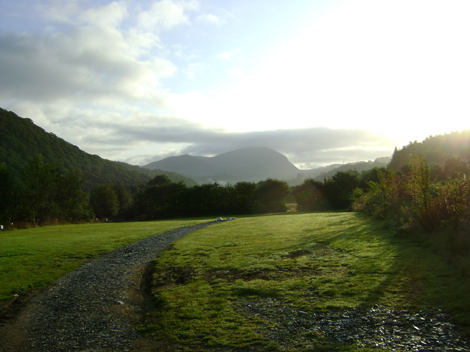 Vale of Ffestiniog
Vale of Ffestiniog
Walking up from Llechrwd Farm, Maentwrog, along the the A469; in the gutters. Hugging the low stone walls built flush to the tarmac, occasionally changing sides to make myself more visible to traffic – the noise of which carries in the mist, giving me some forewarning and time to judge whether I need to take evasive action
All sorts of things have been used to build and fix the walls and fences, I note; wire, iron brackets, railway sleepers, blue brick and the ineludible slate – black and bright in the wet. Its an overcast and damp morning but I make good time without my rucksack to carry, reaching Rhyn-y-sarn and its chipper red phone box after a quarter of an hour, crossing the Afon Teigi and bearing North-east up the hill towards Coed-Penguern, walking in the long grass of the verge that clings and slaps at my boots and makes everything below the knee sodden. On and up while below me the brook tumbles and sings in a gully. I listen to the water and the soft patter of the rain and the high birds in the pine trees as I walk. But for occasional engine noise rising – ‘stutter, shift down, catch, roar, climb, roar,’ or falling, ‘distant drone, louder round the bend, foot down and then, behind me, pull back and break for the blind left-hander in the dip’ – its a peaceful summer morning full of light and green song.
A few miles further on, above Ty’n-y-cefa, I pass a lorry pulled up in a lay-by. The driver stands beside his cab, warming his hands around a mug of tea. As I draw level we nod good morning and he asks if I’m going far. I say that I’m on my way to Blaenau, now visible at the head of the valley. The man tells me about how, when younger, he walked extensively in Brecon – not now though, not for many years, he trails off, his eyes clouded over.
I wonder about him afterwards as I walk on and try to recall what was written on the side of his lorry but can’t remember. He was stocky but light on his feet when he walked; well dressed, clean shaven, early 50s perhaps – a cheerful, open face reminiscent of an older, ruddier James Dean Bradfield. He occupied my mind for the half an hour or so it took to reach the town. Occasionally I looked back over my shoulder, hoping to see the lorry and give the driver a wave so as to break and round off my musings but the lorry did not pass me and I did not see him again. Perhaps he was eating his breakfast; perhaps he swung the wheel around around and drove back down the valley I’d just ascended.
Arriving outside Capel Rhiw at five to nine I am met by Sabine Schlenker, David’s assistant, who walks me through the olive green doors which front the building and into the cool hall beyond. She is very smiley and enthusiastic and asks about my journey up to Blaenau before offering to show me around the building. We walk amongst the running woods, hewn works and cast metal. The chapel is stacked with sculpture, very much as Roger Deakin described it – a congregational throng.
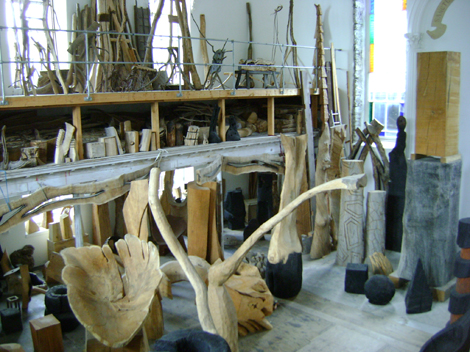 Capel Rhiw
Capel Rhiw
(A door bangs somewhere in the chapel – a voice shouts and echoes)
David – Hello!?
Sabine – Hello! We’re upstairs…
Ah! (Boots drum up the stairs)
This is Daniel.
Pleased to meet you, Sir
Ah, well, you’re about half the age I imagined.
Yes.
Thats refreshing!
(laughter)
Often I’ll write or telephone people and they say ‘Yes, I’ll see you’ and then, when I turn up, they look around for my dad
Great, well, this is much more interesting, this is art not… well
Good, great – thats the reaction I want, not ‘Oh dear, well, could you give your dad a call?’ (laughter)
I remember, in your letter, you said that you were interested in the ways environment affected things
I’m interested in where people work and how that environment affects the work they make so, for example, a person might find a workshop or a space and then begin to inhabit it with their work or collect things that influence and inspire their work – thats one thing – and then there is the process, the tools, the knowledge and journey. What people do, how, where and why… and its the sort of book that nobody under the age of 50 writes and I’m determined to have a go.
Have you read Roger Deakin’s book Wildwood?
Yes, and I was thinking about it as I was walking here; I walked up from Maentwrog
Oh, right
Yes, but the first time I saw your work was the Beech Throne in Bristol Museum when I was young… so I knew of your work before I started on this project but then I was talking to a chap called Stanley Donwood who works a bit with Radiohead about what he does and, at the end of the conversation I asked him who he thought I should talk to next, who would he talk to if he were me? And he said ‘Well, theres this mad bloke who’s got this chapel and its full of wood he can’t get in or out and its just bonkers. Go there!’ And I said ‘Okay, well that sounds interesting, I’ll follow that up.’
(Laughing) An exciting new bit of reputation there!
I was interested in how you could apparently neither get the wood in or out of the building.
Well that was true before I put the big doors in.
Okay, what next? Have you had any refreshment? Are you in need of some caffeine?
I’d love a cup of tea
Okay, we can do that. How far have you got in looking in the chapel?
Sabine has shown me all around but I haven’t looked at anything in great detail as yet
Well why don’t we leave you for 15 minutes here
That would be grand.
I’ll come and find you in 15 minutes, okay?
Thank you.
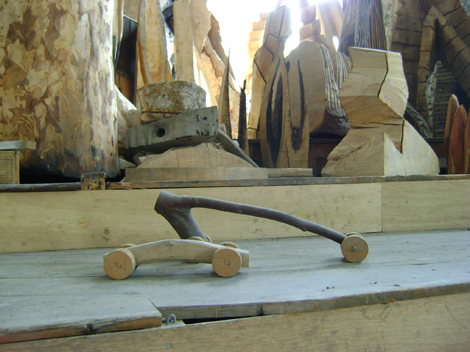
15 minutes of mutterings – recordings and notes
A chair thats been made of pieces of sapling but with all the offshoots left on – a branching, crazy chair form visible within a ball of shoots.
Theres a huge stool and here theres a big spoon, a ladle attached to plinth, its crazed – working in tandem with the wood, leaving the wood to get on with it once you’ve had your conversation – like having a conversation and then leaving the other party to go off and think about it.
twig cars on the floor. I think they’re toys – ‘Nash, 83’ in pencil.
Boxes within boxes.
A throne similar to the one I saw in Bristol museum as a child – like a miso spoon.
Black domes.
The walking tree: four pieces of wood held together with three staves through one tree – a beast or a spider – a beasty.
Spilling box – playing out
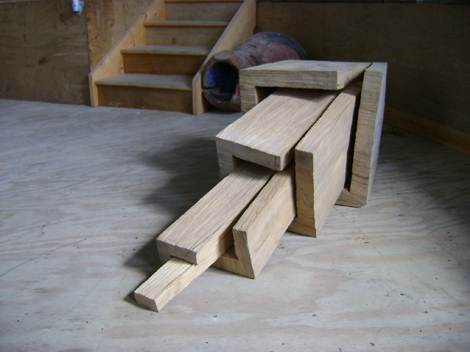
Things that fit inside each other.
Ladders. Quite a few ladders up here, and long boxes; thats what I’d call them – trees cut in 4 ways and then put as to form a long tube, each piece turned like a stocking, turned right, turned right, turned right, held with dowels or pegs, forming a thin upright box.
Lots of A-frames made from wood thats either put together with friction or pushed through itself to give conjoinance.
The squid-like piece, tied round the top and wedges driven up to give it 8 or so legs from a single cleft piece.
A lot of scorched wood. Good smells – rocking back on my haunches to inspect and sniff.
(Moving downstairs – creak creak creak)
Ubus.
A natural tripod with a top like rabbit’s ears
The red rock, fast moving – when I first came in I was talking to Sabine about this piece; Red Flash – Yew, cut at the top – like a deco train poster, this idea of speed.
A low wooden bench with stones on top – cube, sphere, pyramid.
A bowl – with a top like flames. It looks like a thing that could have been the symbol for the Beijing olympics, held together with massive staples in the base.
To put out a hand and touch the textures and grain of these pieces you can understand what David means by the wood ‘pushing back.’
A comet – ball and trailing tail – burnt at the base.
A collection of rough spheres, tufted – axed-off. Coconut textures.
A Bowl. A piece first burned and then cut, creating zebra stripes because of the way the saw’s gone into it, taking away some of the charring and now it looks, after all that, like it’s moving or spinning.
Boats. Hollowed-out forms and others.
I’m walking amongst frozen animals and people, caught in the act – Dr. Who stone angels.
Burnt Square. Circle. Triangle.
In this corner – more crack and warp pillars. This one reminds me of the way my mother cuts bread. An amazing amount of delicacy to go across, each cut layer a centimeter, sometimes less.
Charred beans, giant beans or seed pods, split open and burnt out.
Red Flash looks a little like a hairdryer from this angle.
Amazing trees that must have grown – huge trees to produce there boulders.
A vertical, tall cross the size and bulk of stacked railway sleepers with, possibly, copper around it – the metal is green and lichen-like. Very cold to touch.
On the wall of a side room – the course of the Wooden Boulder drawn in charcoal.
A cast twig chair.
I remember about what Roger Deakin wrote about charcoal and crouch to inspect a small black boulder, carved into planes like a football, determined to put me teeth on edge but its a casting. A dead ringer for wood, it sounds hollow to a knock. I wonder if it sits upon an opening but think it best not to tip it to see.
Burnt wood like sastrugi.
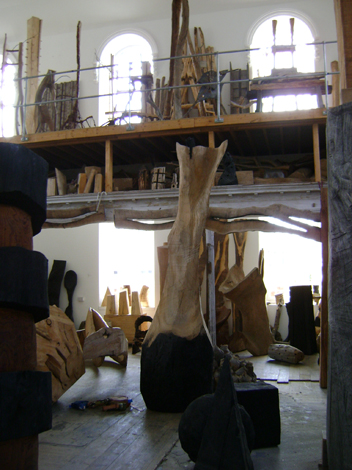
A Conversation Before Tea
(David Returns) Hello!
Hello. Its wonderful
This one will alarm you. (Raps cast boulder. It clangs)
Do you know, thats the one I chose to touch specifically to check what you meant about carbon putting teeth on edge; and I went (mime rapping my hand on the cast with a look of surprise and confusion.)
(Delightedly) Ha! I’ll show you the original – (we walk out into the main room and look at the various castings David has. He points to the giant pair of black miso spoons.)
Now, thats one thing you can do with bronze, you can reproduce. So thats a straight commercial reason and also it can go outside with more durability – someone won’t buy a piece that size for outside and quite right too. (Walks over to the railway sleeper cross) Whereas we poured bronze onto this.
I thought that it must have copper in it.
Thats the natural colour that bronze will grow and thats the colour the burnt wood turned when it was poured over it. I love this black and green.
With the bronze of this (points to the large wooden miso spoons) I just give to the foundry and don’t have to do anything and if somebody buys one and I need another one I just phone up the foundry. They have it all… I sell them in places like Germany where they have a tradition of casting bronze from wood, wood sculpture. They have no feeling that ‘Oh, there’s something wrong here’ like we do in Britain.
So, yes, I’ve been doing some things with cast iron and, interestingly, that (the small twig chair) is much closer to my process. The original is upstairs but its incredibly fragile… and this is actually a better sculpture, I think, than the wood one. I’ve had three done in an edition of six.
Does it still has a flex? It seem to have retained organic properties and I know metal can snap, like wood.
Well, if you ‘bend’ (emphasises the stress by lunging as he speaks it) it will bend and then snap whereas wood would just ‘phut’ because its so dry. The original one is thirty years old.
Have you always done editions of your work or is this a new thing?
I made Wheelies and ladders and little running tables as multiples – that was before I had a gallery. I’d do a show in an alternative space like the Arnolfini in Bristol and make 100 Wheelies, as I call them – wheels on sticks – and sell them… (considers) well, then, 70’s… they would be now £30 each. I sold 100 so thats, well, thats £3,000 now but not really… (laughs)
I have a huge show coming up at Yorkshire Sculpture Park next year – a full retrospective including new work made especially for it which I’m engaged with at the moment. A lot of this will go there too (gestures around the hall.)
Will that be your first retrospective?
Well I’ve done things called Survey Shows because I do tend to tell stories with my exhibitions; theres a narrative within my work. Have you read the Roger Deakin story about the boulder?
Yes.
Well… the only thing that was wrong – he sent me a draft but then he put an end on it after I’d sent it back with some corrections to factual things; he said at the end, he described me rowing up and down the river looking for the thing… well thats just ridiculous! We did do a couple of boat journeys – one looking for it and another filming it floating – so thats where he got the idea from but he wanted to put a romantic…
You’re off in the estuary somewhere…
I searched the estuary when it disappeared for about six months. Not every day by any means but I did make a concerted effort to check every creek, every nook and cranny of the estuary and, when it wasn’t there and I assumed that it had gone to sea. And then I made a film of it for which I made an edition, a box with prints; and then, a year ago, it turned up again – in the estuary, still there. It had got sucked down into some soft sand, got caught up in a tree that had also been sucked down, some branches of which came up above the water – its tidal, you see. I looked there twice because a friend of mine who’s very involved with this, he told me to look. He thought it was there and we went there and it wasn’t, you know? (laughs) It was not there! Five years later its come up, so I’ve had to add that onto the film now… I loved the idea of it having gone out to sea, thats what the film says its done.
Lets go and have some tea. (Leads the way through a door into his house.)
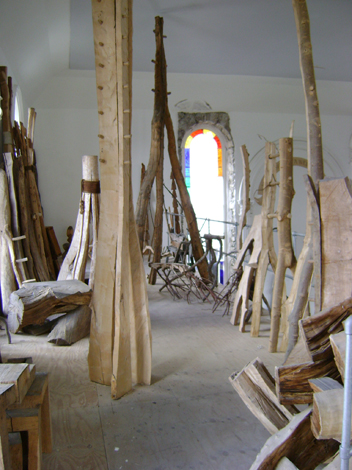
Dan Richards has spent the past year and half meeting with creative people in the places where they are (or have been) creative – travelling all over the country to have conversations in kitchens, dancehalls, condemned factories, chapels, sheds, theatres, hedges, attics, rooves and baths.
He has a blog at http://more-to-life-than-books.blogspot.com/
David Nash’s retrospective at Yorkshire Sculpture Park runs until the 27th February, 2011